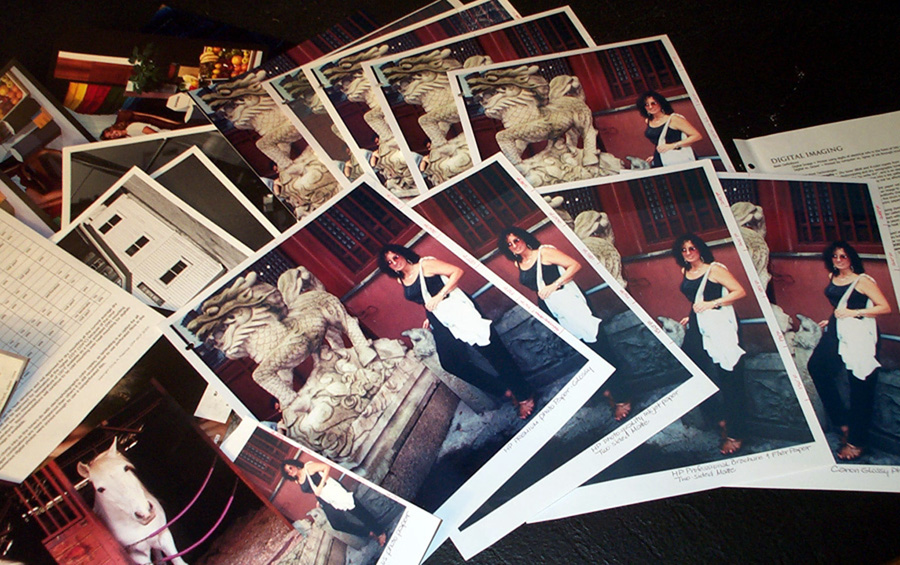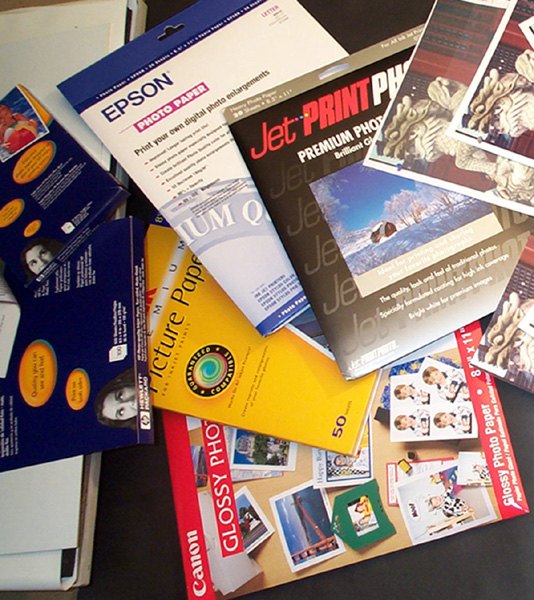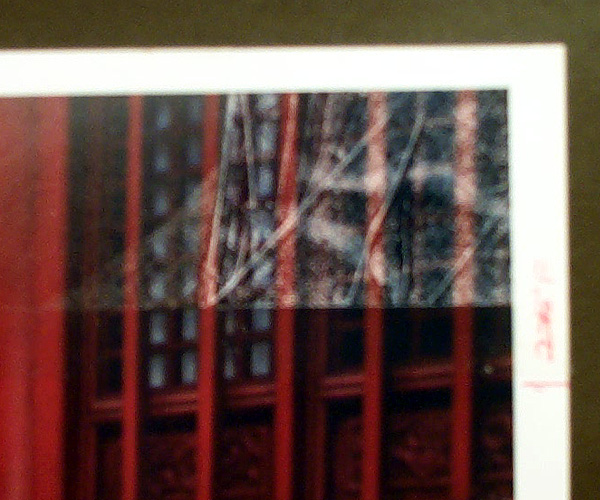 Photo 1
Photo 1
The assortment of printed 8-½x11 photo quality images were printed on an HP DeskJet 960c. Each image was split and heat tested then a strip of laminate was applied.
In my last Digital Directions article "Heat Tolerance Testing", PFM February 2002 I began with a layman's explanation of the basic digital technologies in an attempt to help explain the similarities and differences of each. As framers we need to be able to identify what we have before we can decide how to frame it, that is step one in the designing process known as definition. Hence, we must first define what type of digital it is, or might be (piezo on paper, dye sublimation photo, thermal inkjet digital photo...) in order to know how to best handle it.
I have recently come to realize two things are very different when dealing with the framing of digital prints. First the design questions we ask our customers must change. New ones are needed to better help us identify the image being mounted and/or framed. Second involves the equipment we are currently using to mount these digitals in our shops.
 Photo 1
Photo 1
The assortment of printed 8-½x11 photo quality images were printed on an HP DeskJet 960c. Each image was split and heat tested then a strip of laminate was applied.
Changes in the Design Questions
As the media we are working with has changed so has the approach we must use with our digital customers. As frame designers we have been taught to ask open questions during the creativity stage of the design process. These are questions that may not be answered with a simple one word yes or no. This is when the colors of a room, style of furniture and placement of the art will be disclosed.
With the digital revolution additional questions are needing to be asked, attempting to establish where the image came from and determining if it is a digital or traditional lithograph. We also need to know routinely if another copy is available and if the digital printer is known. For this discussion I am not addressing fine art, limited edition giclees, but rather nondescript printed images, maybe poster prints, maybe photos. Often these duplicate image requests sound negative to us, probably because we fear we need a second one for back-up in case we destroy the first. But the request for a copy need not sound negative to the customer at all.
Asking additional questions that help identify the image is a must, not an option! It is just as important and positive as knowing what color the carpeting is. Ask in a positive tone about the origin and reinforce to them that only with a second copy can one be used for heat tolerance and moisture testing. This will ensure the best mounting technique for the visual enhancement of their image. This is not because you might "damage" the other one, but because you must first test the inks and papers as part of the entire positive framing process. A new concept, but one that needs to be adopted.
 Photo 2
Photo 2
HP Photo Paper, Epson, JetPrint, Kodak and Canon were among the papers tested.
Equipment for the 21st Century
For a while now I have been educating framers and singing the praises of pressure-sensitives as the cold mounting alternative for today's digitals. As mentioned last month in Mastering Mounting, "Pre-adhesive Boards: P-S and HA" the need for understanding pressure-sensitives and their applications is imperative today. We must strive to better understand the differences and limitations of p-s adhesives as low, medium and high tack, and in turn, we must also consider the various application techniques of each. When high tack p-s materials are selected for mounting, the most time effective and foolproof application technique will be with cold roller laminators.
In order to understand the digital world we need to talk the same language. In the digital and sign industry the term "laminator" means the fusion or bonding of multiple layers together, as in carpentry. In framing, we refer to laminating only as a layering of a vinyl glass alternative to the surface of a mounted poster or photo. Roller laminators bond things to substrates, both beneath the image and on top of it.
Five years ago few custom framers had CMCs, ten years ago few had under pinners, fifteen years ago few had hot vacuum presses...perhaps the roller laminator is to be the next new machine in the custom framer's repertoire. With our ever growing awareness of heat intolerance when mounting digitals it isn't a matter of production operations, but more that of the best and safest way to be able to mount an open edition digital.
Since framers often own heat mounting systems the roller laminator needed is a cold laminating version only. This would accommodate p-s polyester over laminating as well as cold adhesive high tack bonding. Both are perfect for digitals. There are new versions of these machines slated to hit the market within the year. I have been told that cold p-s versions, 41" wide laminators with adjustable pressure to accommodate numerous substrate thicknesses should be available for around $2,000.
At this point you may not be convinced that spending for another piece of equipment is necessary, but I guarantee that within a few more years the volume of digital images will make this mounting process the least fearful of all of them. After all, I really did not think the CMC would catch on like it did.
The Testing Series
When conducting my initial heat tolerance test of July 2001, I discovered that thermal inkjet (bubblejet) images on porous paper from an DeskJet 960c tolerated heat from 150°F-200°F, and also tolerated heat-set laminating using vinyls at 225°F. But oddly enough nonporous photos from the same inkjet printer and inks could not tolerate even the lowest 150°F without surface image damage, thus triggered my second heat test, November 2001.
Hypothesis
This test was devised to better determine the heat tolerances of digital photos while using only one printer source. In this way the printer technology would act as a control, inks would remain constant, and only the substrates would be the variable in the test. It has been recorded that printout colors will change over the drying time of a printed digital and I wanted to be certain that all tested inks were as dry and set as possible. Any remaining moisture might impact the heat sensitivities. The same digital photo, enlarged to 8x10" was printed onto full 8-½"x11" photo papers and allowed to dry for one full week prior to heat testing.
Controls
All tested digitals were subjected to mounting temperatures of 150°F (66°C), 170°F (77°C), 185°F (85°C), and 200°F (93°C). Heat tests were conducted in a Hunt 210M-X Mechanical press, and the images were placed under the clamped platen using single sided release paper for a period of 1, 3 and 5 minutes as indicated. All tests were exactly the same.
Then a strip of vinyl laminating film was applied across the top edge and it was placed into a 225°F (104°C), press to test both for heat tolerance and porosity. This is necessary to determine the tolerance of the printed inks under heat mounting and laminating conditions. Both perforated and non-perforated vinyl laminates were applied to the top end strip and placed into the hot press for full laminating temperatures of 5 minutes. Comparisons were made and the results are as follows.
Results at 150°F
The results were recorded on the chart whether positive tolerance or not. If an item is listed as yes it passes the requirements for a quality end product mounting that would meet customer needs without damaging or threatening the digital image. If listed as no there was some form of visible damage resulting from the heat and pressure applications. The viable alternative when a product image failed the heat tolerance would be a pressure-sensitive board, or noninvasive conservation hinging. At no time was lightfastness, monetary value, sentimental value, nor preservation noted. Meaning a signed numbered limited edition giclethough it may tolerate heat of a mounting process should still never be subjected to dry, wet, spray, or pressure-sensitive mounting.
In Heat Tolerances: Part One, the only image damaged at 150°F for 1 minute was the inkjet on photo paper, which prompted this more in-depth study. The damaged ink on photo paper from the original test was an HP DeskJet 960c printer on HP Premium Photo Paper mounted within two hours of printing. The same combination also failed this test, even after a week of curing the ink.
The new chart illustrates the dramatic results of only two digitals showing heat sensitivity at 150°F, the HP mentioned above and Jetprint Photo Paper. There was also visible and unacceptable heat damage to the Jetprint papers by International Paper which are designed for use with all inkjet printers. It has recently come to my attention that Ilford has a line of paper called Jetprint also designed specifically for inkjet dye printers. Maybe this is a factor; the inks might require a specific printer and were impacted here. I still feel that at 150°F (66°C) a standard custom picture framer will be able to heat mount many digital items that are damaged by higher heats.
Higher Temperatures
With the press turned up 20° to 170°F there was no significant difference or damage to the print surface over when mounted at the lower 150 degrees. At even higher temperatures of 185°F the same HP Premium Photo Paper and Jetprint Photo Paper were unacceptable, but the Kodak Premium Picture Paper — High Gloss also failed.
Laminate Results at 225°F
Laminates were tested as both perforated and non-perforated vinyl heat seal laminates. Temperatures were set at 225°F (104°F) and were kept in the press a full 5 minutes. All images tested created acceptable images when laminated and about half did not require perforated films at all. The heavy high gloss photo papers generally seem to react like traditional nonporous photos requiring perforated films for laminating. They will also tolerate peeling after lamination to allow for canvas transferring, but copyright permission still needs to be received before ever doing the transfer.
 Photo 3
Photo 3
HP Photo Paper, Epson, JetPrint, Kodak and Canon were among the papers tested. The upper right corner shows the ink that was peeled away from the substrate when an attempt to reposition the laminate was made within a minute of initial placement.
Other Observations
Since the test was designed to identify surface heat damage, I decided to test the use of Tullis Russell Hot Press Overlay Foil as is suggested to protect traditional gloss photos from release paper silicone. Two complete sets of photos were tested at all times and temperatures, one with new two-sided release paper and one with release paper and a sheet of Hot Press Overlay Foil-Acetate Sheet on the surface of the digital photo.
Results were varied. The HP Premium Photo Paper stuck to the overlay foil indicating an ink sensitivity to heat rather than silicone damage. Kodak Premium Picture Paper-High Gloss somewhat benefited from the overlay foil at higher temperatures, while the others all seemed only slightly improved with it.
The Epson Photo Paper—Glossy showcased a high degree of orange peel in the unprinted photo paper itself, prior to printing of the photo or bonding. The same image did not allow for the typical repositioning benefit of the vinyl laminate without significant ink removal and irreparable damage. This is no doubt due to the fact that Epson printing papers are designed for their Epson piezo inkjet printer technology and not the thermal inkjet printer that actually printed the photo for this test.
Final Chapter
At the February PPFA Conference/PMA Show in Orlando I unearthed a few new pieces for the digital puzzle. It seems I was under the misconception that Epson produced both piezo and thermal inkjet printers, when actually all of their printers, both wide format and desktop, are said to be piezo (aka micropiezo) technology. That tidbit of information has launched me on yet another quest, Heat Tolerance Test #4.
With the support of Epson, I hope, to complete yet another digital photo test similar to the one reported here. Having used the HP DeskJet 960c photo quality printer as the thermal inkjet printer control, I tested numerous porous and nonporous photo media for their tolerance to heat for mounting and surface damage.
The next test will use an Epson photo quality desktop printer with piezo technology as the control, and appropriate Epson piezo papers and the same assorted substrates used here to check for heat tolerances and quality. Welcome to the 21st century and our world of digitals!
END
Copyright © 2002 Chris A Paschke
Note: Again I wish to thank Nielsen and Bainbridge for their support and funding on this project during 2001, and for their continued sponsorship during 2002 allowing me to continue as an ANSI committee member.
For more articles on mounting basics look under the mounting section in Articles by Subject.
Additional information on all types of mounting is found in:
The Mounting and Laminating Handbook, Second Edition, 2002,
The Mounting And Laminating Handbook, Third Edition, 2008 and
Creative Mounting, Wrapping, And Laminating, 2000 will teach you everything you need to know about getting the most from your dry mount equipment and materials as an innovative frame designer.
All books are available from Designs Ink Publishing through this website.
Chris A Paschke, CPF GCF
Designs Ink
Designs Ink Publishing
785 Tucker Road, Suite G-183
Tehachapi, CA 93561
P 661-821-2188
chris@designsinkart.com